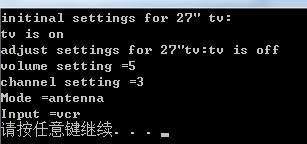一,友元
1)可以将类作为友元,友元类的所有方法都可以访问原始类的私有成员和保护成员。
2)下面例子介绍了 电视类和遥控器类,其中遥控器类为电视类的友元类
3)注意:友元关系不具对称性。即 A 是 B 的友元,但 B 不一定是 A 的友元。 友元关系不具传递性。即 B 是 A 的友元,C 是 B 的友元,但是 C 不一定是 A 的友元。
#include <iostream>
using namespace std;
class TV
{
private:
int state;// on or off
int volume; //assumed to be digitized
int maxchannel;// maximum number of channels
int channel;//current channel settings
int mode;//broadcast or cable
int input;//tv or vcr
public:
friend class Remote;//遥控器类
enum{off,on}; //枚举
enum{minval,maxval=20};
enum{antenna,cable};
enum{tv,vcr};
TV(int s=off,int mc=100):state(s),volume(5),maxchannel(mc),channel(2),mode(cable),input(tv){} //构造函数
void onoff(){
state=(state == on)?off:on;
}
bool ison()const{
return state == on;
}
bool volup();
bool voldown();
void chanup();
void chandown();
void set_mode(){
mode = (mode == antenna)?cable:antenna;
}
void set_input(){
input=(input == tv)?vcr:tv;
}
void settings()const;
} ;
class Remote//遥控器友元类
{
private:
int mode;
public:
Remote(int m=TV::tv):mode(m){} //遥控的是电视而不是 vcr
bool volup(TV &t){ //遥控器的操作都是来源于电视对自身的操作 ,所以友元遥控器的方法都是调用电视的成员函数
return t.volup();
}
bool voldown(TV &t){
return t.voldown();
}
void onoff(TV &t){
return t.onoff();
}
void chanup(TV &t){
return t.chanup();
}
void chandown(TV &t){
return t.chandown();
}
void set_chan(TV &t,int c){ //唯一需要作为友元的方法,因为它用来访问TV类的private成员
t.channel=c;
}
void set_mode(TV &t){
t.set_mode();
}
void et_input(TV &t){
t.set_input();
}
};
/*下面是电视的成员方法实现*/
bool TV::volup()
{
if(volume<maxval)
{
volume++;
return true;
}
else
return false;
}
bool TV::voldown()
{
if(volume>minval)
{
volume--;
return true;
}
else
return false;
}
void TV::chanup()
{
if(channel<maxchannel)
channel++;
else
channel=1;
}
void TV::chandown()
{
if(channel>1)
channel--;
else
channel=maxchannel;
}
void TV::settings()const
{
cout<<"tv is "<<(state == off?"on":"off")<<endl;
if(state == on)
{
cout<<"volume setting ="<<volume<<endl;
cout<<"channel setting ="<<channel<<endl;
cout<<"Mode ="<<(mode == antenna?"cable":"antenna")<<endl;
cout<<"Input ="<<(input == tv?"vcr":"tv")<<endl;
}
}
int main()
{
TV s27;
cout<<"initinal settings for 27\" tv:\n";
s27.settings();
s27.onoff();
s27.chanup();
cout<<"adjust settings for 27\"tv:";
s27.settings();
return 0;
}
输出为:

二,嵌套类
1)嵌套与包含的区别
包含意味着将类对象作为另一个类的成员
对类进行嵌套,不创建类成员,而是定义了一种类型,该类型仅在包含嵌套类的类中使用。struct (结构)实际上是一种嵌套类
2)嵌套类和访问权限
| 声明位置 |
包含它的类是否可以使用 |
从包含它的类派生出来的类,是否可以使用 |
外部世界是否可以使用 |
| 私有部分 |
是 |
否 |
否 |
| 保护部分 |
是 |
是 |
否 |
| 共有部分 |
是 |
是 |
是
|
分享到:











相关推荐
c++primer第五版中文版课后答案(第12章)pdf格式,真正的c++primer习题集(第五版),用手机拍的,但是每个字都能看的很清楚
c++primer第五版中文版课后答案(第17章)pdf格式,真正的c++primer习题集(第五版),用手机拍的,但是每个字都能看的很清楚
c++primer第五版中文版课后答案(第18章)pdf格式,真正的c++primer习题集(第五版),用手机拍的,但是每个字都能看的很清楚
第15章 面向对象编程 471 15.1 面向对象编程:概述 472 15.2 定义基类和派生类 473 15.2.1 定义基类 474 15.2.2 protected成员 475 15.2.3 派生类 476 15.2.4 virtual与其他成员函数 479 15.2.5 公用、私有和受保护...
25.15章 定义基类和派生类 26.15章 动态绑定 27.15章 三种继承 28.15章 派生类的构造函数和析构函数 29.15章 转换与继承 30.15章 友元与继承 31.15章 静态成员与继承 32.15章 纯虚函数与抽象类 33....
c++primer第五版中文版课后答案(第19章)pdf格式,真正的c++primer习题集(第五版),用手机拍的,但是每个字都能看的很清楚
C++Primer 习题解答(第4版),这份资料现在在网上找完整版非常困难,很多都只是一部分习题解答,现把我收藏的这份完整电子版给大家分享下,希望对大家有所帮助!!
vs2013 C++primer5th 15章第9节的例子,Query。编译通过,需要调节的自己调节
c++primer第五版中文版课后答案(第11章)pdf格式,真正的c++primer习题集(第五版),用手机拍的,但是每个字都能看的很清楚
c++primer第五版中文版课后答案(第13章)pdf格式,真正的c++primer习题集(第五版),用手机拍的,但是每个字都能看的很清楚
C++ primer 5th,第十一章——关联容器,笔记&思维导图 按教材整理。
c++primer 第五版,是Lippman写的书 不是那个plus的书,第12章 课后习题答案 需要的参考,以前看书的时候做的 好久了 发现还在就上传上来 有需要的就下吧 应该所有题目都做的除了有的题目连续的就写到一起
C++ Primer习题集(第五版) , 带目录完整版。 --------------------------------------------------------------------------- 目录 第1章............................................................ 1 练习1.1 ...
C++ Primer Plus 编程练习源码工程 第15章 ,这是本人自己学习书籍时写的编程练习的源码工程,供大家参考交流。
文本查询程序,照着树上的代码连接起来的。
C++Primer课后习题解答(第1~16章完整答案)清晰完整版
c++primer 第五版,是Lippman写的书 不是那个plus的书,第12章 课后习题答案 下半部分 需要的参考,以前看书的时候做的 好久了 发现还在就上传上来 有需要的就下吧 应该所有题目都做的除了有的题目连续的就写到一起
c++ primer plus 答案c++ primer plus 答案c++ primer plus 答案c++ primer plus 答案 c++ primer plus 答案
C++primer 课后题答案 目录 第一章 快速入门 2 第二章 变量和基本类型 7 ...第十五章 面向对象编程 116 第十六章 部分选做习题 133 第十七章 用于大型程序的工具 138 第十八章 特殊工具与技术 138
但又是如此美妙的编程语言,在工业界和学术界都可以使用,《C++ Primer(第5版)》即针对初学者,也同样适用于有一定编程经验的读者,第5版配备了C++11新标准,是C++粉丝们书架上必备的一本经典著作。一书在手,架构...